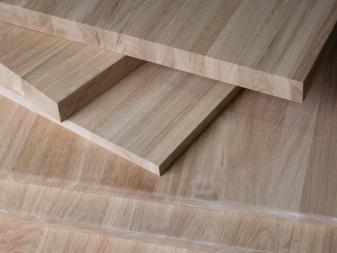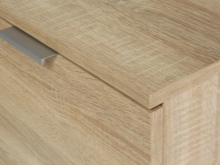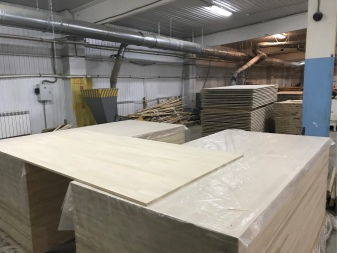Features of oak furniture panels

Oak board retains the structure and color of the wood. It consists of small fragments (lamellas) and resembles parquet in appearance. The interior, which uses oak panels, looks presentable and is filled with a pleasant woody scent.


Description
The furniture board is a solid monolith made from oak or other types of wood through industrial processes. In its creation, solid natural wood is used, and not shavings or sawdust, as in the production of chipboard and MDF. Therefore, it is stronger, more expensive and has a great aesthetic value.
The production of panels makes it easier to install wall panels and create furniture. They are indispensable wherever wood sheets of specific dimensions are required, and not boards or solid wood. Furniture panels are produced in a certain way.
- Felled oak with special equipment sawed into planks certain sizes and dried, bringing the moisture level to 8%.
- Received material dissolve into even smaller fragments called lamellas.
- At the ends of the blanks, toothed spikes are cut along GOST 19414 - 90.
- A special joiner's glue is applied over the spikes and connect the lamellas into long strips. Give them time to dry.
- Then carry out calibration of lamellas. That is, with the help of milling machines, they remove all irregularities, the remains of dried glue and create a geometrically even surface.
- Prepared strips fix together with Kleyberit glue, creating a scale plane. Bonding takes place under pressure. During the collection of the shield, the difference in the direction of the fibers is taken into account. This reduces the internal tension of the web and increases its strength.
- Finished furniture layer clamped in a vice and left to dry for 3-4 days.
- Then again produce surface calibration with the removal of adhesive residues.
- At the last stage, there is cutting the canvases into panels of the required dimensions and their milling.
- Finished sheets are examined for marriage. Small cracks are sealed with a putty, in color, which completely coincides with the shade of oak. In the final version, the restoration of the shield becomes completely invisible.


The shades of the resulting boards can be enhanced with oil or varnish, while maintaining the texture of the oak. All the characteristics of the plant are also preserved. Moreover, new, improved properties are acquired.
- Furniture board that has passed a long and difficult drying process does not crack over time.
- Unlike natural wood panel board product does not shrink.
- Does not deform plane and end side under the influence of the external environment.
- Products have high stability to abrasion and other mechanical stress.
- Canvas environmentally friendly, in its formation, non-toxic adhesives are used.
- The shield is endowed improved performance properties and a longer service life than fiberboard, chipboard and MDF.
- The weight of products from a furniture board is much less than from solid oak... Sheathing the walls with them, you can count on a reasonable load.
- Versatility product allows you to use it for versatile interior furnishings (furniture, wall panels, design decorative elements).
- Appearance paintings are beautiful and flawless, they look presentable and expensive.
Cabinets, countertops, beds and flights of stairs will cost less than natural wood, but more expensive than other types of pressed products (fiberboard, MDF). Therefore, the furniture panel cannot be called budgetary, this is its only drawback. If the shield is made with violations of technology, you will not have to rely on good operational properties.


Species overview
Furniture panels are not veneered material, they are made from bars, and they have a natural oak texture. They can be classified according to quality, manufacturing method, and color. Sometimes products are divided according to the habitat of specific varieties of trees, for example, European cognac, Far Eastern or Caucasian oak shield.
The color palette of this plant is diverse - from almost white to a noble dark shade. But the surprising milky white or ash white furniture tones are deceiving. Oak has this kind of wood only at a young age. Fragile trees are not used in the wood-processing industry, therefore special chemical technologies are applied to the wood, by which a beautiful bleached oak is obtained.
Designers often use shields with shades of sonoma oak, it is also referred to as light types.



The industry provides a large selection of furniture sheets of golden, sand colors, close to the natural straw shade. This category of color palette includes such types as "Golden Oak", "Rustic", "Sedan".
Dark oak surfaces look especially noble. They are achieved in three ways.
- The first one is natural. An amazing variety of oak "Cognac" grows in Europe, which has a natural luxurious dark wood.
- Artificial saturation of tonality is obtained by the method thermal treatment.
- By staining achieve the rarest chestnut, chocolate and other shades.
Oak shields are also presented in a variety of gray and classic brown shades.


Quality classification has its own nuances. The classification of product varieties is indicated by only three letters A, B and C, but by combining them, you can get information about many types of materials.
- Grade A refers to high quality products, where there is absolutely no defect, the structure and color of the fiber are taken into account. The canvas is a harmonious surface with complete coincidence of shades and patterns.
- Grade B in quality it is inferior to the first type, refers to spliced lamellas. The same tonality of the picture is observed, but small cracks are allowed, sealed with a special putty.
- Grade C is of poor quality, traces of knots and cracks can be seen on the surface. It costs less than the previous two types and is not suitable for facade parts of structures.

It should be noted that the sale goes to products marked with two letters at once, each of which carries information about both sides of the shield... This applies to solid wood material. In the designation of spliced shields in front, the letter "C" is added to the two main letters. Therefore, the finished product may have a classification, for example, "AA", "AB" or "SVV" and other similar options.
The boards have different gluing technologies. The lamellas from which the boards are made contain a small width - from 20 to 120 mm. This helps to cope with the internal tension of the wood and, as a result, its deformation.
The technology of gluing wooden plates has two varieties - spliced and solid-laminated.


Spliced
This type of production involves gluing lamellas together into a single sheet along the length and width, that is, from four sides. The length of the workpieces ranges from 200 to 500 mm, and the width is classified as “narrow” (20 mm) and “standard” (40-50 mm). Waste material left over from the production of all-laminated panels is used for the production of narrow lamellas. Despite the high consumption of glue and a more painstaking assembly procedure, products are less expensive than standard options.
Standard spliced technology involves the use of larger workpieces. They are glued together and squeezed under pressure. In contrast to solid-wood products, which look monolithic, the fabric assembled by the splicing method looks like a parquet floor. The large amount of adhesive used in the production of spliced panels makes the products incredibly durable. Kitchen countertops made of this material can last for many years. But staircases made of glued planks will not look attractive; they will need a more holistic structure, which can be obtained by a solid-lamellar gluing method.


Whole lamellas
In contrast to the spliced method, in whole-lamellar production, larger blanks are used, which are glued together on both sides (along the entire length), and then sent to the press. A perfectly matched pattern creates a coherent appearance of the canvas. The length of the stripes depends on the size of the shield, and the width is of different types:
- standard - 40-50 mm;
- wide - from 60 to 120 mm.
Selected wood material is used for solid timber production, and its remnants are used for the production of fused panels. Therefore, the cost of the first option is much higher than the second. The price of the spliced fabric is set per cubic meter, regardless of the length of the product.
In the case of a solid panel, the cost of a product is affected by its length: the larger it is, the more expensive the canvas is.


Dimensions (edit)
Considering the production of shields with spliced and solid timber methods, we figured out that the length and width of the lamellae can vary considerably. Their width is 10, 28, 30 mm and more than 100 mm. As for the overall dimensions of the shield, it turned out that in the domestic market, the most popular are products with dimensions of 900 by 2500 mm, although other options can be purchased. The thickness of the economy class does not exceed 16 mm, the standard is 18-20 mm, and the luxury class is 35-40 mm.


Areas of use
The furniture board has adopted all its wonderful characteristics from oak, down to a pleasant woody aroma. Designers are happy to use it in interiors. This material is used:
- for the manufacture of furniture - wardrobes, beds, pedestals, countertops, headsets;
- for spectacular finishing of the ceiling, floor, walls in residential buildings, cafes, clubs, hotels;
- for the production of stairs, railings, doors, window sills;
- for arranging yards and streets with benches, gazebos, benches.



Selection Tips
The choice depends on the investment, that is, you need to decide whether you need a good shield or a cheap one. The best canvas meets the following characteristics:
- the smaller the width of the product and the greater its thickness, the stronger the material will be;
- the highest quality shields are class A and extra-class;
- if the inner side is not visible in the finished product, you can choose a canvas, one side of which is of the highest quality, and the second is of class B or C;
- solid-laminated board surpasses spliced products in terms of characteristics, appearance, and, accordingly, in cost.


Care rules
Oak furniture board has excellent operational properties, but in order for it to serve for a long time, it needs some care. Products should not be stored at temperatures below 0 degrees, in too hot conditions or in rooms with an excess of moisture. During cleaning, do not use agents with aggressive liquids; it is enough to wipe the dust with a damp cloth.
Furniture made of oak board is not worse in quality and appearance than wood, but it is cheaper. It can be safely introduced into your interior.


For information on how to make an inexpensive oak table from a furniture board with your own hands, see the next video.













The comment was sent successfully.